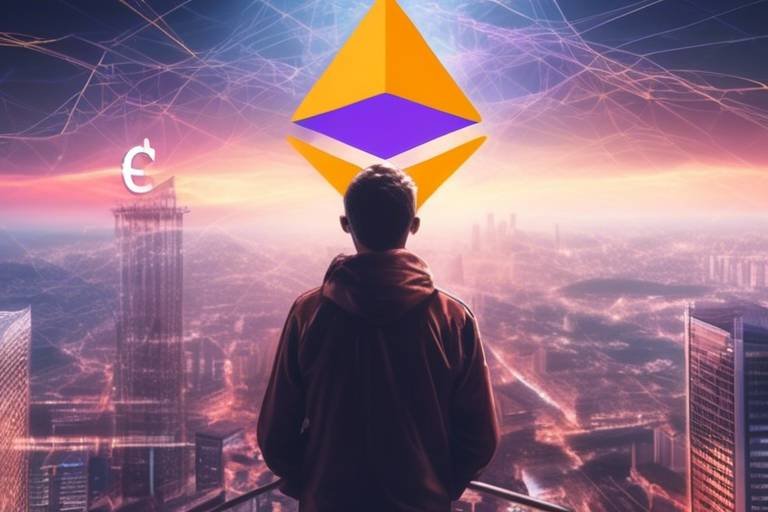Radix - A New Approach to DeFi
In the ever-evolving world of finance, decentralized finance (DeFi) has emerged as a transformative force, reshaping how we think about transactions, investments, and financial services. At the forefront of this revolution is Radix, an innovative platform that is redefining the rules of the game. Imagine a financial ecosystem that not only enhances scalability and security but also prioritizes user experience—this is the promise of Radix. By leveraging cutting-edge technology and a unique architectural design, Radix is paving the way for a more accessible and efficient financial landscape.
So, what makes Radix stand out in a crowded field of DeFi platforms? For starters, it addresses some of the most pressing issues faced by traditional blockchain systems, such as slow transaction speeds and high fees. Radix employs a revolutionary consensus mechanism that allows for faster transactions without compromising security. This means that users can send and receive funds in the blink of an eye, making the whole experience feel seamless and intuitive.
Moreover, Radix is not just about speed; it's about creating a community-driven ecosystem. The platform encourages developers and users alike to engage actively, fostering an environment where innovation can thrive. Whether you’re a seasoned developer or a curious newcomer, Radix offers tools and resources that empower you to explore the vast possibilities of DeFi.
As we dive deeper into the intricacies of Radix, we’ll uncover how its unique technology and features create a robust framework for the future of finance. From decentralized identity management to atomic composability, Radix is not just another player in the DeFi space; it's a game-changer that aims to enhance user trust and security while promoting a more inclusive financial ecosystem.

Understanding Radix Technology
The world of decentralized finance (DeFi) is rapidly evolving, and at the forefront of this revolution is Radix. This innovative platform is not just another blockchain; it’s a completely reimagined approach that addresses the limitations of traditional systems. So, what sets Radix apart? Let’s dive deep into its unique architecture and consensus mechanism, which are the backbone of its impressive capabilities.
At its core, Radix employs a revolutionary architecture known as “Cerberus”. Unlike conventional blockchains that process transactions sequentially, Cerberus allows for parallel processing. This means that multiple transactions can occur simultaneously, significantly boosting the platform's scalability. Imagine a busy highway where cars can travel in multiple lanes at once, rather than being stuck in a single line; that’s how Radix enhances transaction speed and efficiency.
In terms of consensus, Radix utilizes a unique mechanism called “Proof of Stake” (PoS), but with a twist. Instead of relying on a single chain, Radix operates multiple chains that communicate with each other. This structure not only improves the speed of transactions but also enhances security. With traditional blockchains, if one chain is compromised, the entire network can be at risk. However, Radix's multi-chain approach mitigates this risk significantly, creating a more resilient ecosystem.
Moreover, Radix is designed with developers in mind. The platform offers a user-friendly programming environment that supports “Scrypto”, a new programming language tailored for DeFi applications. Scrypto allows developers to create complex financial instruments with ease, enabling them to focus more on innovation rather than getting bogged down by technical limitations. This is akin to giving a chef a high-quality set of knives; it empowers them to create culinary masterpieces without the hassle of inferior tools.
To summarize, Radix's technology is built on three fundamental principles:
- Scalability: The parallel processing of transactions allows for faster operations.
- Security: The multi-chain consensus mechanism enhances the security of the network.
- User Empowerment: Tools like Scrypto enable developers to innovate freely.
In conclusion, Radix is not merely a new player in the DeFi arena; it’s a game-changer. By addressing the scalability and security issues that plague many existing platforms, Radix is paving the way for a more accessible and efficient financial ecosystem. As we continue to explore its features and community engagement, it's clear that Radix is setting a new standard for what decentralized finance can achieve.

Key Features of Radix
Radix is not just another player in the DeFi space; it's a game-changer that brings a host of innovative features designed to enhance user experience and functionality. One of the standout features is its decentralized identity management, which allows users to maintain control over their personal data. This is a breath of fresh air in a world where data privacy is often compromised. Imagine a financial ecosystem where you decide who gets to see your information; that’s the power of Radix!
Another remarkable feature is atomic composability. This concept allows developers to create complex financial products by combining various functions seamlessly. Think of it as building blocks for DeFi applications, where each block can fit perfectly with another, enabling a level of innovation and creativity that was previously unimaginable. This means developers can create more sophisticated and interconnected financial products, all while ensuring that transactions are fast and reliable.
Moreover, Radix boasts a user-friendly interface that caters to both seasoned DeFi enthusiasts and newcomers alike. The platform is designed to make navigation intuitive, ensuring that users can easily access the tools and features they need without feeling overwhelmed. It's like walking into a well-organized store where everything is easy to find; you can focus on what matters most—your financial goals.
Additionally, Radix is built on a unique architecture that sets it apart from traditional blockchain platforms. This architecture not only enhances scalability but also improves transaction speeds, making it a robust option for users who demand efficiency in their financial dealings. In a world where time is money, having a platform that can handle a high volume of transactions without breaking a sweat is invaluable.
To sum it up, the key features of Radix include:
- Decentralized Identity Management: Empowering users with control over their data.
- Atomic Composability: Enabling the creation of complex financial products.
- User-Friendly Interface: Ensuring easy navigation and accessibility.
- Unique Architecture: Enhancing scalability and transaction speeds.
These features collectively create a solid foundation for Radix, making it a compelling choice for anyone looking to dive into the world of decentralized finance. Whether you're a developer eager to innovate or a user looking for a secure platform, Radix has something to offer everyone.
What is Radix?
Radix is an innovative platform designed to enhance decentralized finance (DeFi) by improving scalability, security, and user experience.
How does decentralized identity management work in Radix?
It allows users to control their personal data, promoting privacy and security in the DeFi landscape.
What is atomic composability?
Atomic composability in Radix enables developers to create complex financial products by seamlessly combining various functions.
Is Radix user-friendly?
Yes, Radix features a user-friendly interface that makes it accessible to both experienced users and newcomers.
What makes Radix different from traditional blockchain platforms?
Radix has a unique architecture that enhances scalability and transaction speeds, setting it apart from conventional blockchain solutions.

Decentralized Identity Management
In the rapidly evolving world of decentralized finance (DeFi), identity management is a crucial component that often gets overlooked. Radix takes a bold step forward by implementing a decentralized identity management system that not only empowers users but also enhances overall security in the DeFi landscape. Imagine a world where you have complete control over your personal data, where you can choose what to share and with whom. This is the vision Radix is bringing to life, making it a game-changer in the financial ecosystem.
At the heart of Radix's decentralized identity management is the concept of self-sovereign identity. This means that users are the sole owners of their identity data, stored securely on the Radix network. Unlike traditional systems where third parties hold your information, Radix allows individuals to manage their identities without relying on centralized entities. This not only promotes privacy but also reduces the risk of identity theft and fraud, which are rampant in the digital age.
To illustrate how this works, consider the following key aspects of Radix's decentralized identity management:
- User Control: Users can create, manage, and delete their identity data at will.
- Privacy by Design: The system is built to ensure that personal data is shared only when necessary and with explicit consent.
- Interoperability: Radix's identity solutions can seamlessly integrate with various DeFi applications, enhancing user experience.
Moreover, the decentralized nature of identity management in Radix fosters a sense of trust among users. When individuals know that their data is secure and under their control, they are more likely to engage with DeFi applications. This increased engagement ultimately drives the growth of the Radix ecosystem, creating a vibrant community that thrives on collaboration and innovation.
However, despite the numerous advantages, implementing decentralized identity management is not without its challenges. Regulatory hurdles pose a significant obstacle, as governments worldwide grapple with how to handle digital identities. Additionally, user adoption is another critical factor. Many individuals may still be hesitant to embrace a system that requires them to take ownership of their data. Educating users about the benefits and functionality of Radix's identity management will be essential for overcoming these challenges.
In conclusion, Radix’s approach to decentralized identity management not only enhances security and privacy but also promotes user empowerment. By putting individuals in control of their identity, Radix is paving the way for a more trustworthy and accessible financial ecosystem. As we continue to explore the potential of DeFi, it’s clear that decentralized identity management will play a pivotal role in shaping the future of finance.
- What is decentralized identity management?
Decentralized identity management allows users to control their personal data without relying on centralized entities, enhancing privacy and security. - How does Radix ensure user privacy?
Radix employs self-sovereign identity principles, allowing users to manage their data and share it only with explicit consent. - What challenges does Radix face in implementing this system?
Regulatory hurdles and user adoption concerns are significant challenges that Radix must navigate to successfully implement decentralized identity management.

Benefits of Decentralized Identity
Decentralized identity management is not just a buzzword; it's a transformative concept that can revolutionize the way we interact with financial systems. Imagine a world where you have complete control over your personal data, where you can choose who accesses your information and when. This is precisely what decentralized identity offers to users in the DeFi landscape. By leveraging blockchain technology, Radix provides a framework that enhances privacy, security, and user autonomy.
One of the most significant benefits of decentralized identity is the reduction of fraud risk. In traditional systems, identity theft is a rampant issue, often leading to financial losses and a lack of trust among users. With decentralized identity, users can authenticate themselves without exposing sensitive information. This means that even if a hacker intercepts a transaction, they won’t have access to the user's full identity, significantly lowering the chances of fraud.
Moreover, decentralized identity fosters enhanced user trust. When users know they have control over their data, they are more likely to engage with financial applications. Trust is a critical component in finance; without it, users hesitate to participate. By providing a transparent and secure identity management system, Radix builds a foundation where users feel safe to explore various DeFi products and services.
Additionally, decentralized identity solutions can lead to a more inclusive financial ecosystem. Many individuals, especially in underserved regions, lack access to traditional banking systems due to stringent identity verification processes. With decentralized identity, these individuals can create verifiable identities without the need for cumbersome documentation. This opens the door for millions to participate in the financial world, promoting economic growth and diversity.
However, it’s essential to acknowledge that the implementation of decentralized identity is not without challenges. There are regulatory hurdles to navigate, as governments are still trying to catch up with the rapid advancements in technology. Moreover, user adoption remains a concern; many people are still unfamiliar with the concept of decentralized identity. Education and awareness campaigns will play a vital role in overcoming these barriers.
In summary, the benefits of decentralized identity in the Radix ecosystem are profound. It not only enhances security and privacy but also contributes to building a more inclusive and trustworthy financial environment. As we move forward, embracing this innovative approach could be the key to unlocking the full potential of decentralized finance.
- What is decentralized identity? Decentralized identity refers to a system where individuals have control over their personal data and can manage their identity without relying on central authorities.
- How does decentralized identity reduce fraud? By allowing users to authenticate themselves without revealing sensitive information, decentralized identity minimizes the risk of identity theft and fraud.
- Can decentralized identity improve financial inclusion? Yes, it enables individuals in underserved regions to access financial services without needing extensive documentation.
- What challenges does decentralized identity face? Regulatory hurdles and user adoption are significant challenges that need to be addressed for widespread implementation.

Challenges in Implementation
As innovative as Radix is, it doesn't come without its own set of challenges in implementation. One of the most significant hurdles is navigating the complex landscape of regulatory compliance. Since decentralized finance is still a relatively new frontier, regulations can vary widely from one jurisdiction to another. This inconsistency can create uncertainty for both developers and users. For instance, how can Radix ensure that it adheres to local laws while still maintaining its decentralized ethos? This balancing act is crucial for the platform's long-term success.
Another challenge lies in user adoption. While the technology behind Radix is groundbreaking, getting users to switch from traditional financial systems to a decentralized platform can be daunting. Many potential users may feel overwhelmed by the intricacies of DeFi, leading to a steep learning curve. To combat this, Radix must prioritize user education and create intuitive interfaces that demystify the process of engaging with decentralized finance.
Moreover, the concept of decentralized identity management poses its own set of complications. While empowering users to control their personal data is a fantastic goal, it also raises concerns about security and privacy. If users are responsible for their own data, how can Radix ensure that this information is protected from hacks or unauthorized access? The platform must develop robust security protocols to safeguard user data while also making it easy for individuals to manage their identities.
Lastly, Radix faces the challenge of fostering a thriving developer ecosystem. For the platform to reach its full potential, it needs a diverse array of developers who are willing to build applications on its infrastructure. This requires not only technical resources but also community engagement and support. Radix must actively promote collaboration among developers, providing them with the tools and incentives necessary to innovate and contribute to the ecosystem.
In summary, while Radix is poised to revolutionize the DeFi landscape, it must navigate regulatory challenges, encourage user adoption, secure personal data, and cultivate a robust developer community to realize its vision. The road ahead may be fraught with obstacles, but the potential rewards make the journey worthwhile.
- What is Radix? Radix is an innovative platform designed to enhance decentralized finance (DeFi) by improving scalability, security, and user experience.
- How does Radix ensure user privacy? Radix implements decentralized identity management, allowing users to control their personal data and maintain privacy.
- What are the benefits of atomic composability? Atomic composability allows developers to create complex financial products by seamlessly combining various functions, fostering innovation.
- How can I get involved in the Radix community? Radix actively engages its community through hackathons, educational resources, and feedback loops. You can participate by joining their forums and attending events.

Atomic Composability
Atomic composability is a game-changer in the realm of decentralized finance (DeFi), and Radix is at the forefront of this revolutionary concept. But what exactly does it mean? Imagine being able to create complex financial products effortlessly, combining various functions in a way that feels seamless and intuitive. That’s the magic of atomic composability! In Radix, this principle allows developers to build intricate financial applications that can interact with each other in real-time, without the usual bottlenecks associated with traditional blockchain platforms.
At its core, atomic composability enables a system where transactions can be executed in a single, indivisible operation. This means that if one part of the transaction fails, the entire operation is rolled back, ensuring that no partial transactions occur. It’s like a perfectly synchronized dance where every move is dependent on the others; if one dancer stumbles, the entire performance halts, maintaining the integrity of the show. This feature not only enhances security but also fosters innovation by allowing developers to experiment with new ideas without the fear of catastrophic failures.
In practical terms, atomic composability opens the door to a myriad of possibilities. Developers can create financial instruments that leverage the strengths of multiple protocols, resulting in products that are more robust and versatile. For instance, imagine a lending platform that automatically integrates with an insurance protocol to offer users instant coverage against defaults. This level of integration is not just theoretical; it's becoming a reality on the Radix platform. Here are some of the benefits:
- Enhanced Innovation: Developers can create unique products that combine features from various applications, leading to groundbreaking solutions.
- Increased Efficiency: Transactions can be executed faster and with fewer errors, as everything is designed to work together harmoniously.
- Greater User Experience: Users benefit from a more cohesive and user-friendly interface, making it easier to navigate complex financial landscapes.
However, the potential of atomic composability extends beyond just technical advantages. It also creates a more vibrant ecosystem where collaboration is encouraged. Developers can build on one another’s work, leading to a rich tapestry of interconnected applications. This collaborative spirit not only drives innovation but also helps to establish a more resilient DeFi environment where services can adapt and evolve in response to user needs.
In conclusion, atomic composability is not just a buzzword; it’s a fundamental shift in how we approach financial technology. With Radix leading the charge, the future of DeFi looks promising. As more developers harness the power of atomic composability, we can expect to see an explosion of creativity and functionality that will redefine the financial landscape. The possibilities are endless, and the journey has only just begun!
What is atomic composability?
Atomic composability refers to the ability to execute multiple transactions as a single, indivisible operation. If any part of the transaction fails, the entire operation is rolled back, ensuring integrity.
How does Radix implement atomic composability?
Radix integrates atomic composability into its architecture, allowing developers to create applications that interact seamlessly with one another, fostering innovation and enhancing user experience.
Why is atomic composability important in DeFi?
It allows for the creation of complex financial products that can leverage multiple protocols, leading to increased efficiency, security, and a better overall user experience.

Radix Ecosystem and Community
The Radix ecosystem is more than just a platform; it’s a vibrant community of innovators, developers, and users who are passionate about reshaping the future of decentralized finance (DeFi). At its core, Radix is designed to empower individuals and organizations alike, creating a space where anyone can participate in building and using DeFi applications. This community-driven approach not only enhances the overall functionality of the platform but also fosters a sense of belonging among its users.
What sets Radix apart is its commitment to collaboration. The platform actively encourages developers to contribute to its ecosystem through various initiatives. One of the standout features of Radix is its robust support for developers, which includes comprehensive documentation, tutorials, and access to a network of like-minded individuals. This makes it easier for newcomers to dive into the world of DeFi, reducing the barriers to entry and sparking creativity.
Furthermore, Radix hosts numerous community engagement initiatives designed to keep users informed and involved. For instance, hackathons are regularly organized, providing a platform for developers to showcase their skills and create innovative solutions. These events not only highlight the talent within the community but also serve as a breeding ground for new ideas that can be integrated into the Radix platform.
In addition to hackathons, Radix offers educational resources that cover a wide range of topics related to DeFi and blockchain technology. This commitment to education ensures that users are not only passive participants but active contributors to the ecosystem. By equipping users with the knowledge they need, Radix empowers them to make informed decisions and engage meaningfully with the technology.
Partnerships play a crucial role in the growth of the Radix ecosystem. The platform has formed strategic alliances with various organizations and projects in the DeFi space, enhancing its capabilities and expanding its reach. These collaborations open up new opportunities for users, allowing them to access a broader array of services and products. For instance, partnerships with financial institutions can facilitate smoother transactions and increase trust in the ecosystem.
To give you a clearer picture of the Radix ecosystem, let’s take a look at some of the key components:
| Component | Description |
|---|---|
| Community Engagement | Regular hackathons and educational resources to foster innovation and knowledge sharing. |
| Developer Support | Comprehensive documentation and tutorials to help developers create and launch DeFi applications. |
| Strategic Partnerships | Collaborations with other organizations to enhance functionality and expand reach. |
As the Radix community continues to grow, it remains focused on creating a secure and inclusive environment for all users. The platform’s emphasis on user feedback ensures that the development of Radix is aligned with the needs and desires of its community members. This not only builds trust but also fosters a sense of ownership among users, making them feel like they are part of something much larger than just a financial platform.
- What is Radix? Radix is an innovative platform aimed at redefining decentralized finance (DeFi) through enhanced scalability, security, and user experience.
- How does Radix support developers? Radix offers comprehensive documentation, tutorials, and hosts hackathons to encourage developer engagement and innovation.
- What are the benefits of being part of the Radix community? Members of the Radix community gain access to educational resources, networking opportunities, and the chance to shape the platform’s future through feedback and participation.

Community Engagement Initiatives
At the heart of Radix lies a vibrant and engaged community that plays a pivotal role in shaping its future. The platform recognizes that **community engagement** is not just a checkbox but a fundamental element that drives innovation and user satisfaction. By actively involving users in the development process, Radix ensures that its offerings align with the real needs and desires of its community members. This commitment is evident through various initiatives aimed at fostering collaboration, education, and feedback.
One of the standout initiatives is the organization of hackathons. These events bring together developers, designers, and enthusiasts from all walks of life to brainstorm and create innovative DeFi applications on the Radix platform. Imagine a bustling environment where ideas flow freely, and participants are encouraged to push the boundaries of what's possible. Hackathons not only stimulate creativity but also foster a sense of camaraderie among participants, as they share knowledge and skills in a friendly, competitive atmosphere.
In addition to hackathons, Radix offers a plethora of educational resources designed to empower its community. From webinars to comprehensive documentation, these resources are crafted to demystify the complexities of DeFi and Radix's unique technology. By providing clear and accessible information, Radix is not just building a platform; it's nurturing a knowledgeable community that can confidently navigate the evolving landscape of decentralized finance.
Moreover, Radix places a strong emphasis on creating feedback loops. This means that user input is not only welcomed but actively sought after. Through surveys, community forums, and social media channels, Radix encourages users to share their thoughts and ideas. This two-way communication model ensures that the platform evolves in a way that resonates with its community. It’s like having a conversation with your best friend, where their opinions matter and can influence your decisions.
Furthermore, the Radix community is also supported by a dedicated team that regularly engages with users through social media platforms and community events. This approach not only helps in disseminating information but also fosters a sense of belonging among users. The community knows that they are not just passive participants but active contributors to the Radix ecosystem.
In summary, Radix's community engagement initiatives are designed to create a **dynamic and inclusive environment** where users feel valued and empowered. By organizing hackathons, providing educational resources, establishing feedback loops, and maintaining open communication, Radix is paving the way for a thriving ecosystem that prioritizes user experience and innovation.
Q1: What is Radix?
A1: Radix is an innovative platform that redefines decentralized finance (DeFi) by enhancing scalability, security, and user experience.
Q2: How does Radix engage its community?
A2: Radix engages its community through hackathons, educational resources, and feedback loops, ensuring user input shapes the platform's development.
Q3: What are hackathons?
A3: Hackathons are events where developers and designers collaborate to create innovative applications, fostering creativity and community spirit.
Q4: Why is decentralized identity important in DeFi?
A4: Decentralized identity empowers users with control over their personal data, promoting privacy and security in the financial landscape.

Partnerships and Collaborations
In the rapidly evolving world of decentralized finance (DeFi), are not just beneficial; they are essential. Radix has recognized this critical aspect and has strategically aligned itself with various organizations and projects that bolster its capabilities. By fostering these alliances, Radix is not only enhancing its technological framework but also expanding its reach within the broader financial technology landscape.
One of the standout collaborations involves partnerships with established financial institutions and tech companies. These relationships provide Radix with invaluable insights into regulatory requirements and best practices, which are crucial for navigating the complex world of finance. For instance, a collaboration with a well-known fintech company has enabled Radix to integrate advanced payment solutions that streamline transactions, making the platform more attractive to users.
Moreover, Radix has also teamed up with academic institutions and research organizations to drive innovation in its technology. These partnerships focus on research and development, ensuring that Radix remains at the forefront of DeFi advancements. By tapping into academic expertise, Radix can explore new algorithms and consensus mechanisms that enhance scalability and security, which are paramount in the DeFi sector.
Additionally, the Radix ecosystem thrives on community engagement. The platform actively collaborates with developers and users through hackathons and workshops, encouraging them to contribute ideas and solutions. This community-driven approach not only fosters a sense of ownership among users but also leads to the creation of innovative applications that can be built on the Radix platform. Such initiatives ensure that Radix evolves in a way that meets user needs and expectations.
To give you a clearer picture of Radix's partnerships, here’s a brief overview in the table below:
| Partner Type | Partner Name | Focus Area |
|---|---|---|
| Financial Institution | XYZ Bank | Payment Solutions |
| Tech Company | ABC Technologies | Blockchain Integration |
| Academic Institution | University of Innovation | Research & Development |
| Community Initiative | Radix Developer Community | Hackathons & Workshops |
These strategic partnerships are not just a footnote in Radix’s journey; they are a cornerstone of its growth strategy. Each collaboration brings a unique set of skills and resources to the table, allowing Radix to create a more robust and versatile platform. As the DeFi space continues to mature, these alliances will play a pivotal role in ensuring that Radix remains a leader in the industry, continually adapting and innovating to meet the ever-changing demands of its users.
- What is Radix? Radix is a decentralized finance platform that focuses on enhancing scalability, security, and user experience in the financial ecosystem.
- How does Radix ensure security? Radix implements advanced consensus mechanisms and decentralized identity management to safeguard user data and transactions.
- What are the benefits of partnerships for Radix? Partnerships enhance Radix's technological capabilities, provide regulatory insights, and foster community engagement, driving innovation.
- How can I get involved with Radix? You can participate in Radix's community initiatives, such as hackathons and workshops, or contribute ideas to their development process.
Frequently Asked Questions
- What is Radix?
Radix is an innovative platform designed to redefine decentralized finance (DeFi) by enhancing scalability, security, and user experience. It aims to create a more accessible financial ecosystem for everyone.
- How does Radix differ from traditional blockchain platforms?
Radix utilizes a unique architecture and consensus mechanism that allows for faster transactions and improved scalability, setting it apart from traditional blockchain technologies.
- What are the key features of Radix?
Some standout features of Radix include decentralized identity management, atomic composability, and a user-friendly interface, all of which significantly enhance the functionality of DeFi applications.
- What is decentralized identity management in Radix?
Decentralized identity management empowers users to control their personal data, promoting privacy and security within the DeFi landscape, allowing for a safer financial environment.
- What benefits does decentralized identity offer?
It reduces the risk of fraud and enhances user trust, thereby contributing to a more secure and reliable financial ecosystem.
- Are there challenges in implementing decentralized identity on Radix?
Yes, potential challenges include regulatory hurdles and concerns regarding user adoption, which Radix will need to navigate carefully.
- What is atomic composability?
Atomic composability allows developers to create complex financial products by seamlessly combining various functions, fostering innovation and creativity in the DeFi space.
- How does the Radix ecosystem support its community?
Radix actively engages its community through hackathons, educational resources, and feedback loops, ensuring that user input is integral to the platform's development.
- What strategic partnerships has Radix formed?
Radix has established collaborations with various organizations and projects in the DeFi space, enhancing its capabilities and expanding its reach within the financial technology landscape.



















